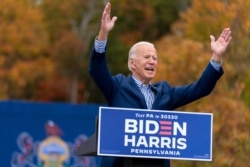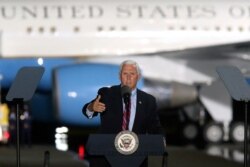Republican U.S. President Donald Trump, his Democratic challenger, former Vice President Joe Biden, and their running mates looked Sunday to fire up their supporters and sway the last remaining undecided voters nine days ahead of the Nov. 3 national election.
Trump headed to rallies in the small northeastern states of New Hampshire and Maine, whose small numbers of electoral votes could prove crucial in a close election. He and Biden are continuing their search for the 270-vote majority in the country’s all-important 538-member Electoral College, where the outcome is determined by the individual state-by-state winners, not the national popular vote.
Trump narrowly lost New Hampshire and its four electoral votes to Democrat Hillary Clinton in 2016 and, according to statewide polls, trails Biden by more than 11 percentage points.
But Trump won one of Maine’s four electoral votes in its rural northern congressional district four years ago and is locked in a tight race with Biden this time for the single elector. But the president trails by a wide margin in statewide polls for two electors awarded to the overall winner in the state and for the other congressional district elector in Maine, which is situated along the country’s northern Atlantic coastline.
Meanwhile, Biden on Sunday night is speaking virtually at an “I will vote” concert. While Trump has continued to stage large outdoor rallies of supporters, often at airport hangars, in the face of the surging coronavirus pandemic in the United States, Biden has adopted a more measured approach to campaigning. He has appeared at small gatherings, or often, as he is Sunday, via a computer livestream.
Trump’s running mate, Vice President Mike Pence, has also appeared at rallies and is planning an appearance Sunday night in Kinston, North Carolina, another closely contested battleground state. Trump won the state in 2016 but polls show Biden holding a narrow edge this time.
Senator Kamala Harris of California, Biden’s running mate, is in yet another crucial state, Michigan in the Midwest heartland, for appearances in Detroit, Troy and Pontiac.
Trump captured an upset 2016 win in Michigan, a traditionally Democratic state, which along with victories in Pennsylvania and Wisconsin, handed him a four-year term in the White House.
But polls show Trump falling nearly 8 percentage points behind in Michigan and trailing by smaller margins in Wisconsin and Pennsylvania as well.
All three states are crucial to the 2020 outcome, as are several other battleground states that Trump won in 2016 but where he now trails. In the national popular vote, aggregations of polls show Biden ahead by 8 or 9 percentage points.
More than 58 million Americans have already voted, about two-thirds of them by mail and about a third in person, with many of them saying they wanted to do so ahead of Election Day to avoid coming face to face with other people amid the coronavirus pandemic in long voting lines that are expected.
Polls show that perhaps less than 5% of voters have not decided on voting for Trump or Biden, making it especially imperative for their two campaigns to identify their existing supporters and make sure they cast ballots.
Many early Democratic supporters of Biden have told news reporters they wanted to be among the first to vote against Trump, to try to help ensure he is the third U.S. president in the last four decades to lose a bid for re-election after a single term.
Meanwhile, many Republicans say they plan to vote on Election Day, as has been the norm for decades in the U.S.












